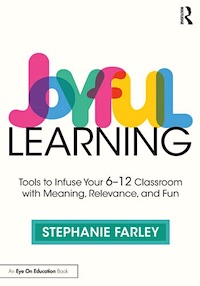The Best Performance Based Assessment Ever
By Stephanie Farley

I also like seeing people who are masters at their craft engage in their work, like hearing a story by David Sedaris or watching an episode of Iron Chef. The Lemon Twigs concert was both masterful and an expression of the band’s love for music.

Hear The Lemon Twigs, Long Island brothers Brian and Michael D’Addario, here.
Returning to my classroom in the days after the concert, I considered the adolescents in my 8th grade English class. They, too, were on a journey of mastery, practicing the craft of writing and trying to produce work that was as engaging and effervescent in its own way as that of The Lemon Twigs.
Turning up the joy in summative assessment
With required final exams looming, I resolved to create a summative assessment experience for my students that would allow them to demonstrate what they knew and could do in a way that was as joyful as a concert at The Hollywood Bowl.
As I thought about the experience, the year’s major learning targets were at the forefront of my planning. Among these were identifying big ideas in literature, making connections between the big ideas in literature and the wider world, writing with a purpose in mind, and developing the skill of voice in writing.
The concept I developed for the summative assessment was to invite students to a “dinner party,” which would be held during the final exam time slot.
Students would come to the dinner party as a character from one of the novels or stories the class had read during the year. These were randomly assigned by drawing the character’s name from a hat. Dressing up as the character was optional.
Before the event, there were three writing requirements:
1. As their character, students had to write a series of questions for the other dinner guests. The questions, students were directed, should reveal the spirit of their assigned character. For example, Ralph from Lord of the Flies probably wouldn’t ask people about their interests or attitudes; instead, he’d want to know whether anyone has spotted Jack’s location or if the fire on top of the mountain was still active.
2. As their character, students had to write a response to the essential question for the class, in the face of monsters, madness, and mayhem, what makes life worth living?
3. As themselves, students had to write what they knew as a result of the class that they hadn’t known before.
The particular cohort of students to whom I introduced this concept was a bit theatrically inclined: many of them performed in the school’s drama productions and some of them even took acting classes outside of school. There was definitely synergy between the people and the idea.
Replacing review with preparation
My students dug into the preparation. Some of them were really jazzed about the costuming aspect – showing up for the dinner party in a cape and top hat – while others were more elaborate in their presentation of the three written assignments.
For example, one of the students was assigned the character of Miles Sperry from Kelly Link’s story “The Wrong Grave.” The story opens with Miles trying to retrieve his (likely) bad poetry from the grave of his former girlfriend. My student wrote his three final exam assignments as poems carefully arranged in a leather-bound journal.
As was true for any assessment, I gave feedback at predetermined check points and talked through students’ ideas with them. Of course, the writing was completed before the dinner party, so by the day of the exam all that was left to do was to share what the students had written.
From mingling to table talk
Sharing happened in two ways: the first was “mingling” when the students arrived. In this mingling phase, the students spoke to each other as their assigned characters, asking each other the questions they’d prepared. During this time, I walked around, listened, and took notes. I had already read the questions the students wrote, so I just observed how these question-and-answer sessions went. Of course, students had to answer the questions as their assigned character.
The second way in which sharing happened was gathered around a large table. Each student read out loud their response to the essential question, and then they read what they had learned in English class.
The atmosphere in the room was warm and lively; while there may have been some awkwardness at first, students quickly settled into their roles. And when they shared their written assignments, as had been our practice throughout the term, each student was offered appreciative feedback and encouragement from the group.
Students surpassed my great expectations
The work products were some of the best I’d ever seen. Listening as my students embodied their characters – acting, thinking, and speaking like a fictional person – I experienced the same awe as when I saw The Lemon Twigs in concert.
Through performance-based assessment, this group of 13-14 year olds demonstrated their mastery of character, big ideas, and connections. And when the students shifted into their explanation of what they had learned, I saw that they had also mastered purpose and voice. Not only had the students met the expectations of the learning targets, they had exceeded them.
I floated back to my workspace after the dinner party. That particular summative assessment, I knew, was a hit. Every student had been able to demonstrate their mastery of the learning targets, and every student had been acknowledged and appreciated for their contributions.
Together, the students and I had created a joyous community in which we learned and grew. It was the best performance-based, summative assessment ever!

Stephanie’s first book, Joyful Learning: Tools to Infuse Your 6-12 Classroom with Meaning, Relevance, and Fun (Routledge, 2023), is now available. She has created professional development for schools around reading and curriculum and coaches teachers in instruction, lesson planning, feedback, and assessment. Visit her website Joyful Learning and find her other MiddleWeb articles here.































